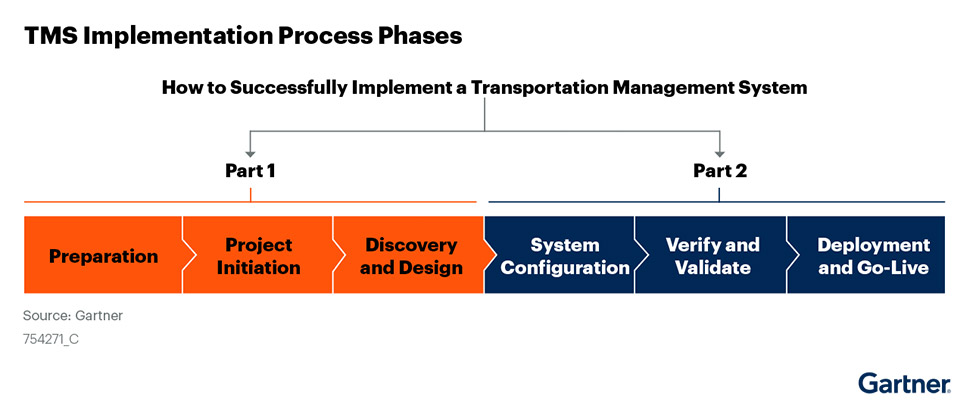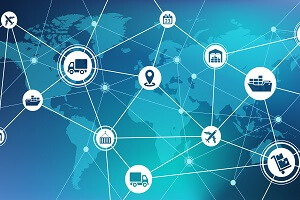As the global economy becomes a more complex and interconnected puzzle, transportation management systems (TMSs) become more imperative with each invoice. Knowledge of shipments at a moment’s notice creates efficiency, and any business that utilizes a TMS has a competitive edge.
Logistics is a key player in the supply chain, and without a transportation management system, it’s easy to be overwhelmed when it comes to keeping track of the various parts of the puzzle. Integrating such a system into logistics management increases productivity by providing end-to-end visibility and allows teams to pivot if the need arises.
According to Forbes, the TMS market became the breakout star of 2021 amidst lockdowns and the pandemic and solidified them as a sound business investment. With the profitability of TMSs from both the developer and logistics point of view, we can expect that these systems can become only more useful over time.
What Is A Transportation Management System?
 A TMS is a digital platform that allows logistics teams to plan, execute, and track cargo and freight movement. It is a tool that utilizes automation, data, and machine learning to fast-track otherwise tedious processes. These programs allow for transparency in every step of the shipping process.
A TMS is a digital platform that allows logistics teams to plan, execute, and track cargo and freight movement. It is a tool that utilizes automation, data, and machine learning to fast-track otherwise tedious processes. These programs allow for transparency in every step of the shipping process.
A TMS can track many parts of a shipping network, including but not limited to manufacturers, distributors, fleets, forwarding services, and logistics teams. Some examples of tasks a TMS can handle are generating routes or estimating quotes for potential clients. Many of the programs operate in real-time.
As businesses of all shapes and sizes utilize transportation management systems, the modes of transport and the actual make-up of loads vary greatly. A TMS can help trace vessels, planes, trains, and vehicles. These deliveries can be bulk, parcels, or palettes. Some companies use TMSs to account for internal assets as well as wholesale and customer orders. Goods tracked through a TMS can be inbound or outbound, international or domestic.
Is A TMS Right For Your Team?
Transportation management systems are an invaluable tool for teams of any size. In short, any business that moves freight and cargo needs help to do that. By automating basic processes, businesses can become more standardized, flexible, and confident.
Some benefits of a TMS include optimizing delivery time, decreasing overall expenses, improving warehouse efficiency, lowering risk, and heightened customer satisfaction. This is useful for B2C and B2B groups alike. A TMS can be used by manufacturers, distributors, forwarders, and retailers.
While a TMS may seem like one small part of the entire supply chain, it is a critical tool in allowing businesses to run smoothly while garnering customer loyalty. There are also supplemental programs that businesses can also consider to maximize productivity, such as warehouse management systems, or WMS, as well as enterprise resource planners, or ERP, which can integrate with both transportation and WMSs.
Overall, the most attractive aspect of integrating a TMS is reducing risk. While pandemic-related delays continue, container shortages and changing politics, all create bottlenecks, but logistics teams can fortify their responses to disruptions through data-backed insights and quick execution of mitigations.
In the transportation industry, TMSs are paving the way for better business. Logility, Inc. reports that 30% of companies see increased customer satisfaction after a TMS integration. The same survey reveals that companies can be more customer-focused and react to customer needs through time-saving measures introduced by a TMS.
Benefits Of Transportation Management Systems
 Two critical benefits transportation management systems provide are cost and time savings. Keeping the customer happy involves a smooth-running supply chain, and this is provided through automation. Overall, a TMS can offer four main advantages to a business: efficiency, improved visibility, flexibility, and an environmental edge.
Two critical benefits transportation management systems provide are cost and time savings. Keeping the customer happy involves a smooth-running supply chain, and this is provided through automation. Overall, a TMS can offer four main advantages to a business: efficiency, improved visibility, flexibility, and an environmental edge.
Efficiency
An effective TMS increases efficiency by saving time and lowering costs. For example, a TMS can help plan for load consolidation and then execute multi-stop routes. While actual package handling and packing can still be a manual process, you can easily automate backend work. Moreover, a TMS tracks data and can generate reports, allowing for analysis that will prevent delays and overspending down the line.
Efficiency extends to instances where an order needs to be returned. Whether an item is defective or simply sent back, a TMS can aid in transfers to other services such as repair, refurbishment, or disposal.
These reverse situational logistics rely on streamlined carrier selections, service level agreements, and other miscellaneous logistical constraints. Even in returns that are multi-stops or highly specialized, such as oversized items or hazardous materials, the process can be made easier.
Improved Visibility
Part of creating efficiency is allowing for on-the-spot decision-making, which a TMS enables. Not only does heightened visibility allow for immediate adaptation to challenges, but it also enables future changes to occur almost seamlessly. This not only helps shippers but customers as well, who can track packages and trust that their purchase is safe from departure to arrival.
Many TMSs integrate a security aspect. Not only can trusted carriers be chosen through a transportation management system, but they can also illuminate security breaches or suspicious activity.
While this is a worst-case scenario, finding cost savings through technology can allow expenses to be allocated to other aspects of a business, such as packaging that prevents transit damage or an upgraded in-house fleet. No matter the innovations made to a company’s supply chain, they likely can be tracked through a TMS.
Flexibility
In a 2021 study from Auburn University’s Center for Supply Chain Innovation, 67% of logistics management respondents cited sourcing flexibility as a top priority. In this context, sourcing flexibility is the ability to change suppliers, which is a high-ticket item as the global supply chain is still in recovery.
An adaptive transportation management system integrates multiple carrier APIs to toggle between providers or seamlessly get involved with split containers. More advanced systems will also have in-app solutions that can provide real-time recommendations, becoming a marketplace of sorts for carrier options.
Environmentalism
While environmentalism might not seem like an immediate benefit of a TMS, it definitely cannot be excluded. For instance, with more efficient load make-ups and optimized routes, distribution centers would have less back and forth.
Another example is that with a more interconnected system and ease of use, there is more opportunity for repair and refurbishment of broken products rather than sending these items to be destroyed or disposed of.
Tips For Using A TMS
While moving to a whole new system or improving on one can be a daunting task, there are genuine benefits to doing so. The following are three tips on how to adjust workflows and other best practices.

Embrace New Technology
As a fast-growing industry, transportation management systems are now utilizing newer technologies, which include things like automation and the cloud. Similarly, as TMSs become more advanced, the previously mentioned warehouse management systems are also being developed further.
Using a WMS allows businesses to optimize their processes from the very beginning. Keeping a warehouse organized affects numerous aspects of the supply chain, such as lead times and inventory quality.
Therefore, warehouses need to be kept in optimal conditions, either by ensuring that equipment such as scales or forklifts are current or by following best practices such as stacking inventory vertically to save space. Arrangement and the contents of the inventory can be tracked through inventory management software or a WMS.
Some of these workflows in both TMSs and WMSs are done via automation. Automation is used to provide speed while reducing the chances of human error. Scales can interface with WMSs to provide accurate data that you can further integrate with the TMS. All of these systems can be stored in the cloud, reducing the data storage burden on businesses.
Adjust Workflows
The entire point of updating workflows is to make the organization run smoother. To aid in the onboarding of new employees as well as train existing ones, changes will need to be reflected in training materials and standard operating procedures accordingly.
Recognizing team learning styles will also allow training materials to be more adaptive to everyone. Progress made using new systems should be shared widely to encourage the use of the new system.
Not only should internal teams edit their definitions of success using the new system, but the way customers can save time and money should also be highlighted. You can now adjust quotes to match new optimized timelines for expected pickups and deliveries, as well as the cost savings that will be implemented. At this stage, there would also be room to analyze packaging, fleets, and route length.
Customer First Mindset
It goes without saying that any business should have its customer base in mind for any decision, whether the company is B2C or B2B. Throughout the pandemic, many customer bases have changed their expectations for how long they must wait for their items between ordering and receiving. Utilizing a new TMS to shorten wait times can be a key to business differentiation.
The Future Of Transportation Management Systems
 With the success of transportation management systems through the pandemic, it’s clear they are here to stay. As time goes on, TMSs’ integration with other in-house systems, such as WMS and CRMs, will become more seamless.
With the success of transportation management systems through the pandemic, it’s clear they are here to stay. As time goes on, TMSs’ integration with other in-house systems, such as WMS and CRMs, will become more seamless.
Additionally, with customers now becoming accustomed to luxuries like same-day shipping, two-day deliveries, and on-demand visibility, transportation management software will become key to managing customer expectations.
Transportation management systems at one point were mostly geared towards trucks and left out much-needed support for rail, plane, and vessel operations. In this era, managing these non-vehicle modes was a more laborious task, and switching from one to the other was even more labor intensive.
This also applies to moving freight between levels of service or to a new carrier entirely. These inadequacies impacted quotes for both cost and time. However, with technological progress, these types of systems are now considered outdated, if not slowly becoming obsolete.
Because TMSs have become more customer-centric, the days of an amalgamation of various tracking, batching, and task distribution systems are over. Now, multiple aspects of a business can be on the same page, rather than all operating in their own sphere.
Depending if a business operates domestically or internationally will likely affect the overall need for a modern TMS. For example, India is currently building out a more interconnected railway system, while Amazon tested a drone delivery system in 2016 for the UK. Even El Pollo Loco tested food delivery by drone in 2021. Whether a delivery system is familiar or cutting edge, a TMS is needed.
Bring Your Business Vision To Life With Transportation Management Systems
The goal of any transportation company is customer satisfaction, which means expedient and secure transfers of goods. In addition, staying current on technological innovation, whether it’s a drone delivery or an electric vehicle fleet to even just a modern TMS, is what allows businesses to scale and garner more profit.
At Orases, we know that no two businesses are the same, and all have their own challenges and nuances. Having the right software development partner is key to moving your company forward. With two decades in operation and purpose-driven culture, Orases can meet your needs. Reach out to schedule a consultation today.






